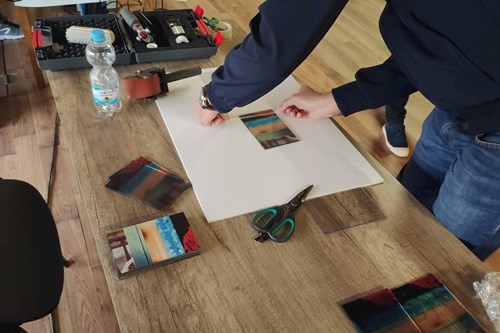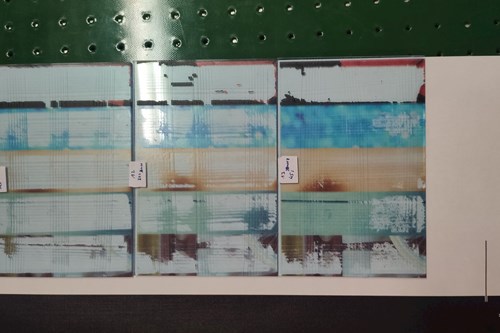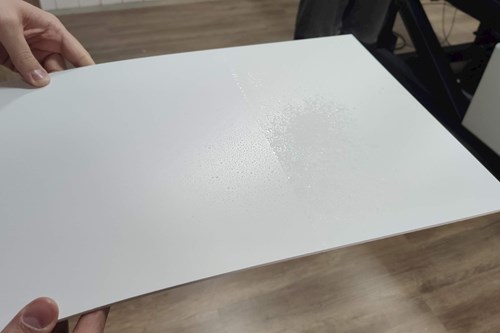Plasma as a tool to improve the quality of UV digital printing
Modern UV digital printing continues to challenge printers. Not all material types are suitable for large-format digital printing. Scientists from the Plasma Nanotechnology and Bioapplication Research Group at the Department of Physical Electronics can increase the print adhesion to the substrate and, therefore, the print quality precisely by using atmospheric plasma.
23 Aug 2023
Tereza Schmidtová
Atmospheric plasma treatments can change the surface properties of materials. Our research group has long been involved in developing and implementing atmospheric plasma technologies in the industry. One such project is plasma technology for UV digital printing.
UV digital printing is a technology that can print not only board and roll material but also non-absorbent materials such as plastics, glass, wood, etc. Unlike conventional printing (e.g., screen printing, offset printing, letterpress printing), it does not need any printing form. Printing takes place from digital data transmitted directly to the printing press.
UV digital printing is complicated. The ink droplets are cured by UV radiation. However, most polymers often do not hold the ink print on themselves and are, therefore, unsuitable for UV printing. It was in response to the needs of the market and the wishes of its customers that the printing company Effetec decided to try to remove this obstacle. Research on plasma treatment to improve the adhesion of various materials for UV digital printing has been addressed by researchers at the DFE since 2019 within the framework of the TAČR TRIO project FV0114. Scientists from the PNB research group participated in the project with the printing company Effetec. Effetec, based in Čelachovice na Hané, is active in digital printing internationally, and the company manufactures, sells, and services UV digital printing machines.
The project's leader was the managing director of Efferec, Lukáš Obšel. The project's principal investigator for MUNI was Ing. Miroslav Zemánek, Ph.D.. Alas, due to serious health issues, he had to leave the work. Assoc. Prof. Dušan Kováčik took over the research with Dr. Jakub Kelar, Dr. Zlata Kelar Tučeková, Dr. Oleksandr Galmiz, Assoc. Prof. Pavel Slavíček and Slavomír Sihelník. Seven students were involved in the project, not only from the field of physics of nanotechnology but also from general physics and astrophysics. All students gained valuable experience in laboratory and scientific work in the context of working with an industrial partner and their requirements.
However, the project was not without complications. From the very beginning, the Covid pandemic hindered the collaboration. "We couldn't test the adhesion of the ink because we didn't have any printing machines, which are large and expensive. We could not travel to Effetec. Eventually, through the Effetec director, we made arrangements with one of Effetec's customers here in Brno. The first experiments, which tested our hypotheses from the laboratory research, were carried out there," comments Dr. Kelar.
The scientists tested the adhesion of the print to the substrate using a so-called cross-cut test. The surface of the printed material is scratched with a special knife in two directions. The tape is then pressed and torn off. If the adhesion to the substrate is poor, the material delaminates significantly after tearing, and the print is destroyed. However, with a suitable plasma treatment, the adhesion is improved. The print is not so severely destroyed. The print, therefore, adheres better to the substrate. Look at the photo gallery to see how the researchers conducted the testing.
Through their research, scientists improved the print adhesion to the substrate. Dr. Kelar adds, "We incorporated our DCSBD in a technically adapted form, the so-called plasma module, which serves as a plasma source, directly into the printing press itself. Now, the company has a unique product on the market, controlled by a single software with predefined parameters for the material. The plasma treatment takes place on-site. They can even upgrade their older printing machines with an add-on plasma module."
The result of all this effort is a new proven technology for increasing the adhesion of large-format UV digital printing inks to glass and polymer substrates by atmospheric plasma activation. The researchers presented their results at several conferences. The technically implemented result, i.e., a prototype and a working sample, is the universally attachable plasma module for the printing machine, which scientists created beyond the promised solution of the project.
Effetec is now working with Masaryk University on the legal aspects of this applied research and is moving into the phase of promoting the research results and commercialization. The new plasma module will likely soon be launched on the market. Our scientists are maintaining an active relationship with Effetec and are looking forward to new project challenges and further opportunities for collaboration.







